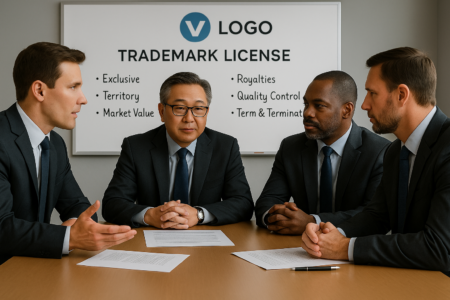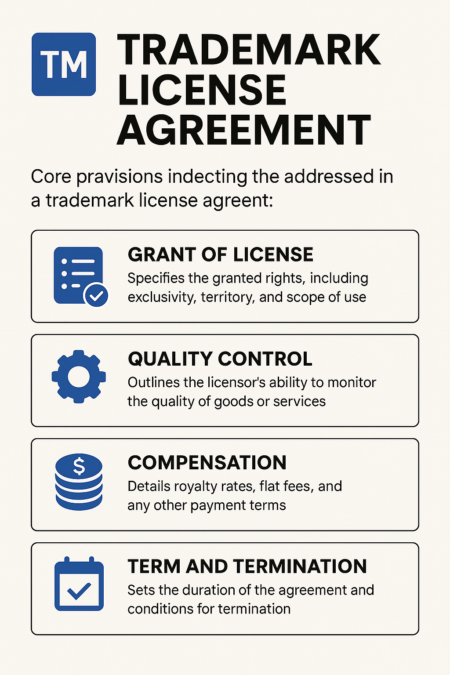
A trademark license agreement is a transaction in which one business (licensor) allows another (licensee) to lawfully use the licensor's trademark in exchange for a licensing fee. A trademark license agreement allows a licensee to leverage a licensor's established brand recognition without owning the mark. For the licensee, the agreement provides rapid market entry, reduced marketing costs, and access to consumer trust. For licensors, trademark licensing generates revenue and extends brand reach without direct expansion.
License agreements are essential in franchising, merchandising, and co-branding strategies. When properly structured, they protect brand value while enabling commercial growth. Without a license, unauthorized use may constitute trademark infringement, exposing the unauthorized user to legal liability. Trademark licenses are effective tools for monetizing intellectual property and scaling operations efficiently within defined legal and quality control boundaries.
For business owners unfamiliar with intellectual property law, learning how these agreements work may translate into a better understanding of the value of strong trademarks and the business opportunities available through trademark licensing. This guide explains the key provisions and practical considerations of a trademark license agreement in plain language.
A trademark license agreement is a legally binding contract in which the licensor grants certain rights to a licensee to use the mark in connection with specified goods or services, in exchange for compensation. Licensing is often used when the licensor wants to expand into a new geographic area, industry, or marketing channel without directly operating there. For example, a clothing company might license its mark to a retailer to develop clothing stores under the clothing company's trademark. These agreements can cover service marks and traditional trademarks, and typically define rights concerning use, exclusivity, quality control, territory, and termination.
A trademark license can be based on a common law trademark, a state trademark registration, or a federal trademark registration. Each form provides differing levels of legal protection, geographic scope, and evidentiary advantages.
Common law trademarks arise automatically through use of a mark in commerce, even without registration. They are enforceable within the geographic area where the mark is used and recognized by consumers. While sufficient to form the basis of a license, they offer limited protection and are harder to enforce, particularly across state lines.
State trademark registrations provide protection within the boundaries of the registering state. They offer some procedural benefits, such as inclusion in a searchable database, but remain limited in scope. State registration may be appropriate for purely local businesses but lacks the national presumption of validity provided by federal law.
Federal trademark registrations, issued by the United States Patent and Trademark Office (USPTO), offer the strongest legal foundation for a license. They provide nationwide constructive notice of ownership (15 U.S.C. § 1072), a legal presumption of validity and exclusive right to use the mark nationwide (15 U.S.C. § 1115), and the ability to bring suit in federal court. A federally registered trademark can also be recorded with U.S. Customs and Border Protection to prevent the importation of infringing goods.
In a licensing context, federal registration gives licensors stronger control and enforcement options and enhances the marketability of the license. Licensees are more likely to invest in promoting a brand backed by a valid, enforceable federal trademark registration.
While each agreement is tailored to specific business goals, most include these essential elements:
This clause specifies what rights are being granted. It defines:
Courts have emphasized that a valid trademark license must include provisions for quality control to ensure that the licensor maintains control over the nature and consistency of the goods or services offered under the mark. See Eva’s Bridal Ltd. v. Halanick Enterprises, Inc., 639 F.3d 788 (7th Cir. 2011). Without such oversight, the arrangement may be deemed a "naked license," which occurs when a licensor allows use of its trademark without retaining control over product or service quality. See FreecycleSunnyvale v. Freecycle Network, 626 F.3d 509 (9th Cir. 2010). Naked licensing can result in abandonment of the trademark under the Lanham Act, rendering the mark unenforceable and potentially destroying its value entirely.
The licensor is legally required to maintain control over the nature and quality of goods or services sold under the licensed mark. This obligation reflects a core principle of trademark law: the protection of consumers. Trademarks function as source identifiers, assuring consumers that the products or services bearing the mark originate from a single source and meet consistent quality standards. When a trademark is licensed, quality control provisions help preserve that assurance by preventing variations that could mislead consumers.
Courts have long held that this requirement safeguards not only the goodwill of the trademark owner but also the public interest in reliable purchasing decisions. If a licensor fails to monitor the licensee’s use of the mark, it risks engaging in “naked licensing,” which can result in the loss of trademark rights. The licensor does not need to control or constantly monitor the licensee's operation. However, quality control provisions must be present in a trademark license agreement and provide the licensor reasonable oversight (e.g., approval of the licensee's proposed trademark use and semiannual product reviews).
Trademark license agreements typically include detailed payment provisions tailored to the commercial goals of both the licensor and licensee. Common compensation structures include flat fees, which are one-time or periodic lump-sum payments for the right to use the trademark. These may be appropriate for short-term or narrowly scoped licenses.
More commonly, licensors receive royalties based on the licensee’s sales of products or services bearing the licensed mark. This approach aligns the licensor’s compensation with the success of the licensee’s use and incentivizes both parties to maximize revenue. Royalties may be calculated as a percentage of gross or net sales, and may include additional provisions defining deductible expenses or adjustments for returns. A central principle in royalty negotiations is that the royalty rate should reasonably reflecting the fair market value of the trademark. However, the parties to the agreement are free to define the rate upon mutual agreement.
Agreements often incorporate minimum royalty requirements, which obligate the licensee to pay a specified amount regardless of actual sales. This protects the licensor from underperformance. In some cases, “most favored nation” clauses are included to ensure the licensor receives terms at least as favorable as those granted to any other licensee of the same mark.
Additional compensation terms may require reimbursement of advertising or promotional expenses incurred by the licensor, particularly when cooperative marketing efforts are involved.
The term of a trademark license agreement can be either for a fixed duration, such as one, three, or five years, or perpetual, subject to specific conditions. Agreements often include provisions for automatic renewal or renewal upon mutual agreement, provided certain performance metrics or compliance standards are met. Termination clauses are critical and typically permit one or both parties to terminate the license early in cases of material breach, such as nonpayment of royalties, unauthorized use, failure to maintain quality control, or the insolvency or bankruptcy of either party. These clauses must be drafted with clarity to ensure enforceability and predictability.
A comprehensive agreement will also outline the notice requirements for termination, including the form, delivery method, and timing of such notice. Post-termination obligations should be explicit, particularly regarding whether the licensee must immediately cease all use of the trademark, destroy related marketing materials, and cooperate in de-branding efforts to prevent ongoing consumer confusion or inadvertent infringement after the license ends.
To allocate risk, most agreements include indemnity provisions. Licensors are sometimes asked to indemnify the licensee against third-party claims of trademark infringement. However, this can expose the licensor to significant liability, so licensors often limit indemnity to “known claims” or include disclaimers of warranty.
Third-party infringement claims pose significant risks to licensees, potentially halting operations, disrupting supply chains, or damaging valuable customer relationships. To manage this risk, trademark license agreements often include indemnity provisions, which function like insurance policies, requiring the licensor to defend or reimburse the licensee for losses arising from trademark disputes. These clauses are particularly important when a licensee relies heavily on the licensed mark to market and sell products or services.
However, licensors must carefully structure indemnity obligations to avoid assuming unlimited liability. Rather than agreeing to blanket indemnification, licensors often limit their obligations to claims that result from their own breach of warranty, misrepresentation, or negligence. Additionally, agreements typically require the licensee to provide prompt notice of any third-party claims to allow the licensor to respond in a timely and strategic manner.
Licensors may also reserve the right to approve or control settlement decisions, ensuring that the resolution of any claim aligns with their business and legal interests. These limitations help strike a fair balance between protecting the licensee and preventing the licensor from bearing excessive or unforeseeable risk, especially in complex or uncertain enforcement landscapes.

Trademark licensing offers significant strategic and financial benefits for both licensors and licensees. For companies that own well-known or even moderately recognized trademarks, licensing creates an opportunity to monetize underutilized assets, generate passive revenue streams, and expand into new markets without bearing the full risk and cost of direct operations.
From the licensee’s perspective, gaining access to an established trademark allows a business to reduce marketing and promotional costs, enhance consumer trust, and accelerate product acceptance by leveraging existing brand recognition. This is especially valuable for startups or companies entering new geographic or product markets.
For the licensor, licensing provides a means to extend brand visibility, increase market penetration, and generate income while still retaining ownership and control over the trademark. The ability to grant only certain rights, such as use in a defined territory or for a specific class of goods, preserves long-term brand value and strategic flexibility.
However, the success of any trademark licensing venture depends heavily on clear contractual terms, rigorous quality control, and the involvement of experienced legal counsel to mitigate risk and prevent disputes.
A trademark license agreement is a powerful tool that, when executed properly, can deliver substantial commercial benefit while safeguarding the interests of both the licensor and licensee. However, failure to address key provisions, such as quality control, compensation, liability, and termination, can jeopardize the value of the mark and expose the company to substantial legal risk.
Whether you're licensing a mark to grow your business or seeking to leverage someone else’s brand, it’s essential to involve experienced legal counsel, verify the validity of the mark, and ensure that all obligations are clearly defined and binding.
If you are considering entering a trademark licensing situation or other trademark matters, contact our office for a free consultation.
© 2025 Sierra IP Law, PC. The information provided herein does not constitute legal advice, but merely conveys general information that may be beneficial to the public, and should not be viewed as a substitute for legal consultation in a particular case.

"Mark and William are stellar in the capabilities, work ethic, character, knowledge, responsiveness, and quality of work. Hubby and I are incredibly grateful for them as they've done a phenomenal job working tirelessly over a time span of at least five years on a series of patents for hubby. Grateful that Fresno has such amazing patent attorneys! They're second to none and they never disappoint. Thank you, Mark, William, and your entire team!!"
Linda Guzman

Sierra IP Law, PC - Patents, Trademarks & Copyrights
FRESNO
7030 N. Fruit Ave.
Suite 110
Fresno, CA 93711
(559) 436-3800 | phone
BAKERSFIELD
1925 G. Street
Bakersfield, CA 93301
(661) 200-7724 | phone
SAN LUIS OBISPO
956 Walnut Street, 2nd Floor
San Luis Obispo, CA 93401
(805) 275-0943 | phone
SACRAMENTO
180 Promenade Circle, Suite 300
Sacramento, CA 95834
(916) 209-8525 | phone
MODESTO
1300 10th St., Suite F.
Modesto, CA 95345
(209) 286-0069 | phone
SANTA BARBARA
414 Olive Street
Santa Barbara, CA 93101
(805) 275-0943 | phone
SAN MATEO
1650 Borel Place, Suite 216
San Mateo, CA, CA 94402
(650) 398-1644. | phone
STOCKTON
110 N. San Joaquin St., 2nd Floor
Stockton, CA 95202
(209) 286-0069 | phone
PORTLAND
425 NW 10th Ave., Suite 200
Portland, OR 97209
(503) 343-9983 | phone
TACOMA
1201 Pacific Avenue, Suite 600
Tacoma, WA 98402
(253) 345-1545 | phone
KENNEWICK
1030 N Center Pkwy Suite N196
Kennewick, WA 99336
(509) 255-3442 | phone
2023 Sierra IP Law, PC - Patents, Trademarks & Copyrights - All Rights Reserved - Sitemap Privacy Lawyer Fresno, CA - Trademark Lawyer Modesto CA - Patent Lawyer Bakersfield, CA - Trademark Lawyer Bakersfield, CA - Patent Lawyer San Luis Obispo, CA - Trademark Lawyer San Luis Obispo, CA - Trademark Infringement Lawyer Tacoma WA - Internet Lawyer Bakersfield, CA - Trademark Lawyer Sacramento, CA - Patent Lawyer Sacramento, CA - Trademark Infringement Lawyer Sacrament CA - Patent Lawyer Tacoma WA - Intellectual Property Lawyer Tacoma WA - Trademark lawyer Tacoma WA - Portland Patent Attorney - Santa Barbara Patent Attorney - Santa Barbara Trademark Attorney